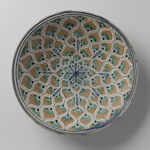
There’s pottery and then there’s majolica: decorated ceramic design from Italy that dates back to Renaissance days. The MAK’s exhibition shines a light on the role of majolica in art and history.
- Features highlights from the MAK and other collections
- Also one or two contemporary works
- Curated by the globe’s leading expert
- Some 220 pieces on display
- Runs April 6 – August 7, 2022
- See also:
- Design exhibitions in Vienna
Tin glazing and image culture

(Majolica basin with tripartite foot and handles, Urteil des Paris, Patanazzi Workshop, Urbino, around 1560–1590 © MAK/Georg Mayer)
Mention the word majolica in Vienna and thoughts turn to the colourful façade of the late 19th-century Majolikahaus, with its Alois Ludwig-designed floral tiles.
True majolica (also known as maiolica), however, refers to tin-glazed earthenware from Italy. The opaque white tin glaze serves as a canvas for colourful designs and depictions.
Sometimes art, sometimes daily crockery, and sometimes luxury tableware: majolica first appeared during the Renaissance and continues today in modern ceramic and art studios.
This branch of ceramic creativity has rarely held the spotlight in the way that painting has. But you understand its importance to the Renaissance and art history in general when you realise great artists like Raphael (1483 – 1520) produced templates and patterns for majolica workshops.
The Tin Glazing and Image Culture exhibition at the MAK pays due tribute to this historical and cultural role. It presents highlights from the museum’s extensive majolica holdings, complemented by loans from other collections and juxtaposed with one or two beautiful contemporary works.
As well as viewing the often exquisite nature of the items themselves, you get to benefit from the expertise of the world’s leading expert on all matters majolica.
Timothy Wilson (Emeritus Professor of the Arts of the Renaissance at the University of Oxford) curated the exhibition together with the MAK’s own Rainald Franz.
The plates, bowls, vases and other vessels illustrate various aspects of the majolica story, including:
- The historical development
- Majolica’s cultural, representative and practical roles
- Typical motifs (e.g. biblical and mythological) and their source material
- Centres of excellence and the work of notable individuals with such resonant names as Francesco Xanto Avelli
You also encounter different styles and ornamental traditions. I enjoyed the white ground grotesque-style painting from Urbino, particularly the inkstand. The decoration reminded me of the Hall of Grotesques at Lower Belvedere palace.
Tickets & dates
Enjoy the colourful pleasures of Majolica from April 6th to August 7th, 2022.
A simple ticket for the MAK museum includes access to this special exhibition. During its first few weeks, look for the huge Josef Hoffman exhibition in the same building for more design delights.
Should you wish to see the turn-of-the-century version of majolica on the house designed by Otto Wagner, then go left outside the MAK and follow the giant Ring boulevard until you reach the opera house.
After the opera house turn left again down Operngasse and then merge on to the Linke Wienzeile. The Majolikahaus is at number 40.
How to get to the MAK
See the main MAK article for travel tips. Once inside, make you way down a floor to find the exhibition just to the right of where the stairs emerge.
Address: Stubenring 5, 1010 Vienna